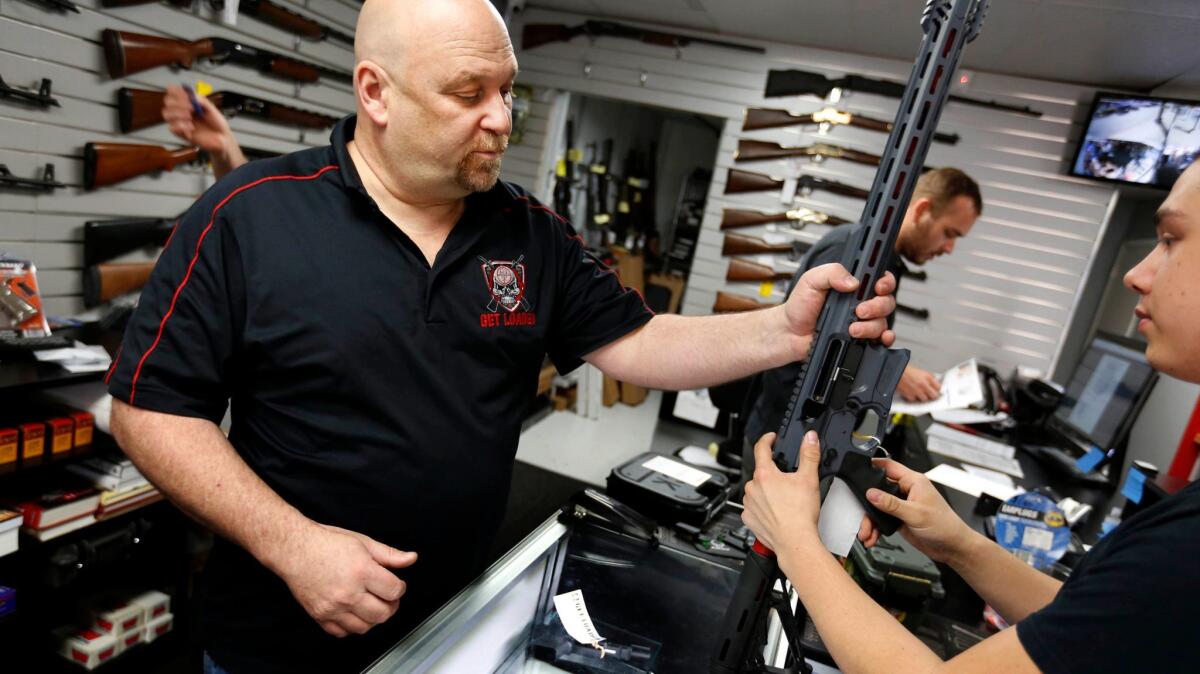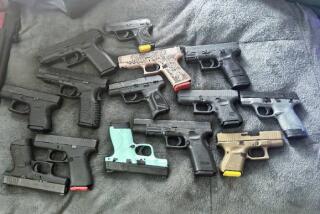After mass shootings, Californians respond by acquiring handguns

- Share via
Long after the victims are laid to rest and the shell casings are collected and cataloged, new research shows, mass shootings have a lasting ripple effect: For several weeks after the mayhem stops, a shooter’s deadly rampage pumps a higher-than-usual number of firearms into general circulation in the United States.
A study published this week in Annals of Internal Medicine finds that in the six weeks following the 2012 shootings at an elementary school in Newtown, Conn., acquisitions of handguns in California alone ticked 53% higher than usual rates.
And, in the six weeks following the 2015 shootings in San Bernardino, in which 14 were killed and 22 others seriously wounded, handgun purchases in the state increased 41% over normal sales volumes.
In and around the city of San Bernardino, the spurt was especially dramatic: Gun sales there rose by 85% in the six weeks following the rampage by American-born Syed Rizwan Farook and his Pakistani-born wife, Tashfeen Malik.
The additional 53,000 handguns that found their way into California households following the Newtown and San Bernardino assaults represent a tiny fraction of the estimated 30 million firearms privately owned statewide. But the study suggests that mass shootings are prompting the introduction of handguns into households that had never had them before, and spurring gun ownership among people — including women and Latinos — who have rarely bought them in the past.
As mass shootings continue unabated, the additional gun sales they spur have the power, bit by bit, to nudge the nation’s arsenal of privately held weapons — estimated to be 310 million in 2009 — ever higher.
“A large number of smaller spikes could add up to a major addition to the number of guns in a community,” said Stanford University injury-prevention researcher David M. Studdert, the study’s lead author.
The new findings, drawn from gun acquisition records in the Golden State, may well be a conservative gauge of how much mass shootings drive increases in gun sales and ownership. In California, would-be gun buyers must clear many more hurdles than exist in most states, including a 10-day waiting period, a purchase limit of one gun per month and a safety training requirement.
In an editorial published alongside the new study, Daniel W. Webster, director of the Johns Hopkins Center for Gun Policy and Research, wrote that in states with fewer restrictions and a more robust culture of gun ownership, “it seems likely that gun acquisitions inspired by mass shootings would be greater.”
The new findings didn’t just document increases in gun sales. They compared sales in the brief period following a highly publicized shooting to well-established patterns of gun sales, which vary seasonally and with events such as national elections.
The finding that gun sales exceeded expected levels jibes with less rigorous observations by gun researchers and journalists, who frequently chronicle runs on gun stores following mass shootings.
But the motives that drive those purchases are a matter of intense debate. Some have argued that those increases are largely driven by gun enthusiasts. Anecdotal evidence suggests that, in the wake of mass shootings, many gun owners fear the adoption of new limits on access to firearms. These consumers act quickly to buy or stockpile controversial weapons while they can.
That impetus may only be part of the picture. Instead, the new research offers evidence that in the wake of mass shootings, some citizens — probably rattled by the randomness of these events — conclude that owning a gun will make them safer.
The new study’s dissection of gun sales following two widely publicized events points to self-defense as an important prod to gun buying after a mass shooting. In particular, gun acquisition among two groups of people — women and first-time gun owners — bolsters that conclusion.
As buyers of handguns, men typically outnumber women 10 to 1. While men continued to be the leading buyers of handguns after a mass shooting, the bump in handgun purchases by women was 75% higher than usual after the Newtown shooting and 50% higher after the San Bernardino attack. (For men, the sales increased 48% and 38%, respectively, after the two shootings.)
People who had never bought a gun before were disproportionately more likely to buy a gun in the aftermath of a mass shooting as well. Handgun purchases by first-time buyers rose 72% more than expected after Newtown and 52% more than expected after San Bernardino, compared with increases of 35% and 29%, respectively, among established gun owners.
In the wake of the shootings in Newtown, the National Rifle Assn.’s Wayne LaPierre famously asserted that “the only thing that stops a bad guy with a gun is a good guy with a gun.”
“The research says exactly the opposite,” counters Dr. Garen Wintemute, an emergency department physician who directs the violence prevention research program at UC Davis. A welter of research on households and states has found that higher rates of gun ownership are consistently linked to increased risks of suicide, of death or injury resulting from domestic violence and of firearms-related violence and injury, he noted.
That so many consumers react to mass shootings by bringing a handgun into the home means “we have been unable to translate our research knowledge into public awareness,” Wintemute said.
The new analysis did not consider rifles, which in 2014 and 2015 accounted for 45% of all firearm acquisitions in California. State data suggest, however, that before and after San Bernardino, the acquisition of such “long guns” saw increases that tracked with those seen in handgun sales. So handguns “may represent only about one-half of the total firearm acquisition response in California” to the San Bernardino shooting, the study authors suggested.
Regardless of how they are defined (whether three or four people must be killed, for instance), mass shootings have become a regular — some say escalating — feature of American life. If they drive even modest bumps in handgun ownership, “the cumulative effect of such ‘shocks’ ... may be substantial,” the authors concluded. “These events may drive nontrivial increases in overall firearm prevalence, which may in turn increase the risk for firearm-related morbidity and mortality in the long run.”
As “durable goods,” Wintemute noted, handguns can be expected to last for decades. And so might the risks that come with owning them.
“Someone may buy a handgun in his 20s and use it to kill himself in his 60s,” said Wintemute. “There’s the potential for long-lasting harm every time one of these events occurs, and there’s this excess in purchases.” That’s especially true, he added, when that post-shooting boost in purchases extends gun ownership to households that had never had a firearm.
“It just ratchets the risk up one extra notch,” Wintemute said.
MORE IN SCIENCE
Presidential politics has increased job stress and sapped workers’ productivity, psychologists say
Detailed look at the global warming ‘hiatus’ again confirms that humans are changing the climate
Here’s the nothingness Cassini heard as it flew through the empty space between Saturn and its rings







